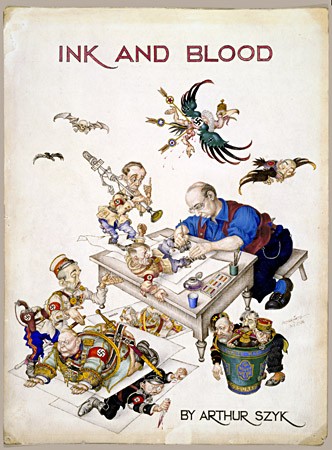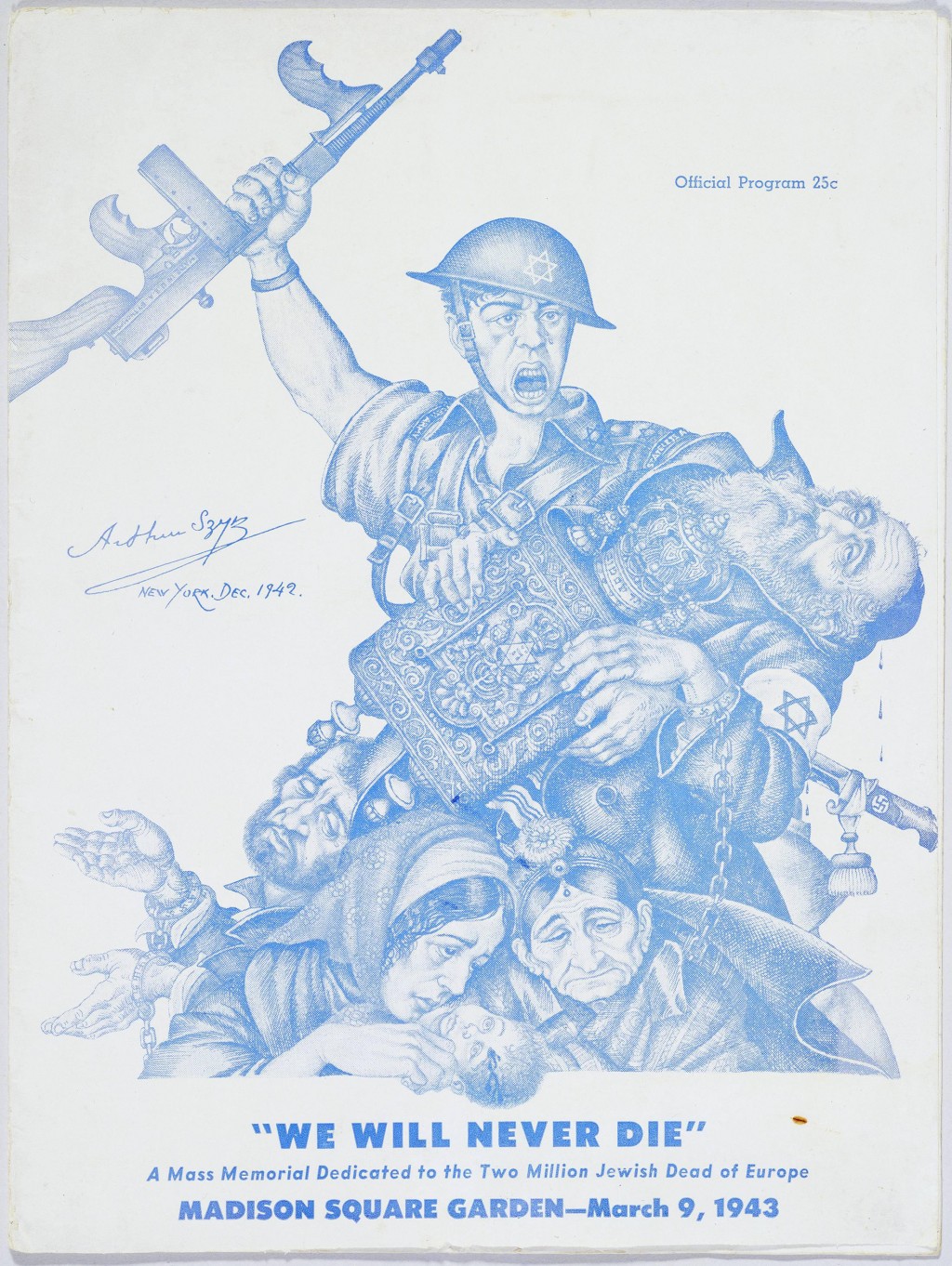
The Art and Politics of Arthur Szyk
Arthur Szyk became one of America's most prominent cartoonists and caricaturists during World War II. Throughout the 1940s, his images reached millions of people through exhibitions, magazines, and newspapers. Szyk prided himself on being a propagandist for the Allies. Szyk's images, especially after 1942, were aimed at mobilizing American public opinion in order to win popular and political support for Jewish rescue during the Holocaust.
Introduction
Artist Arthur Szyk (1894–1951) earned an international reputation during his lifetime for his richly detailed illustrations and illuminations of Jewish themes. Szyk was a skillful caricaturist and a passionate crusader for political causes. From his early childhood in the Polish city of Lodz until his death in New Canaan, Connecticut, he drew inspiration from the history of his people. Szyk found strength in biblical stories of Jewish bravery and martyrdom, and in more modern examples of courage.
During World War II, Szyk (pronounced “Shick”) devoted his energies to defeating Nazi Germany and its allies and calling the world’s attention to the mass murder of Europe’s Jews.

His incisive wartime cartoons and caricatures filled the pages of American newspapers and magazines, earning him a reputation as a “one-man army” in the Allied cause. His moving portrayals of Jewish suffering and heroism bespoke a political activism that demanded “action—not pity.”
By 1943, Arthur Szyk had become perhaps America’s leading artistic advocate for Jewish rescue from Nazi Europe. His images appeared in leading magazines and newspapers such as Collier’s, Esquire, Time, Look, Liberty, the New York Post, and the Chicago Sun. During the darkest periods of the war, Szyk’s images reached millions of Americans, helping to boost morale by unmasking the threat that Nazism posed to Western civilization.
Jewish Artist
Szyk's artworks and illuminations portrayed the Jews as a heroic nation that had resisted oppression through the ages and eventually triumphed. His Jews were fighters for their own freedom and the freedom of others. Szyk sought to redefine how Jews viewed themselves and how others viewed them. His works thus challenged the notion that Jewish history was merely one long saga of suffering and recast the Jews as assertive actors in shaping their own destiny. Zionism played a crucial role in Arthur Szyk's art and politics and his artwork glorified biblical heroes as models for the "new Jew."
Wartime Caricaturist
Art has often played a crucial role in wartime propaganda, serving to stress the justness of one nation or cause by contrasting it with the enemy's depravity, deceitfulness, and barbarity. To boost morale at home, while sanctifying the need for military intervention, propagandists seek to unmask the opponents' evil intentions, often portraying or dehumanizing them as criminals, beasts, or monsters. Humor too plays an important role by reducing fears of the enemy's invincibility.
Adolf Hitler's toothbrush mustache and outlandish ideas made him a perfect target for cartoonists. Szyk's many depictions of the Nazi leader range from the comic to the terrifying. His first cartoons of the Nazi leader, dating back to the mid-1930s, show Hitler as an enemy of the Jews. After the outbreak of World War II, Szyk caricatured Hitler as a madman bent on territorial conquest, a string-pulling conspirator manipulating Axis leaders, and Death's faithful companion. For Szyk, Hitler represented more than just a lone ranting politician; he was the political expression of a militaristic Germany. During the war, Szyk was a full-time soldier in the war against the Axis powers and sought to win support for the Allied cause.
Following the German invasion and occupation of much of western Europe during the first half of 1940, Szyk earnestly felt that exhibitions of his artwork could help win public support in the United States for the European Allies.
Action—Not Pity
Few artists did as much as Arthus Szyk to make the American public aware of the horrors of Nazi antisemitism and the tragedy of the Holocaust. Szyk's goal was to call attention to the problems of European Jewry, not just to evoke sympathy for the victims but to wage war on their behalf, to demand "action—not pity." [The slogan "action—not pity" served as the watchword for the Zionist Revisionist Bergson group, and it appeared on many of their advertisements.]
During World War II, Arthur Szyk was perhaps the most prominent artist in the United States advocating the rescue of Jews. When Hitler came to power in Germany in 1933, the artist immediately began attacking the regime for its anti-Jewish policy. Szyk's political cartoons of the 1930s included works that exposed the resurgence of antisemitism. In April 1933, he drew an image of a tortured German Jew being forced by Storm Troopers to sign a statement denouncing foreign anti-Nazi criticism as "atrocity propaganda."
His fervor increased with the outbreak of war. Though too old to serve in the military, he saw himself as a soldier in the crusade against the Nazi enemy. By 1940, he realized that Nazi antisemitism was of an "exterminatory brand" and he sought to bring the suffering of the Jews to the world's attention. Alerting the world to Nazi crimes and urging action to stop them became his primary mission. The Allies, he believed, were treating the plight of the Jews like "pornography"; "nobody denies it, but you cannot discuss it in polite society."
Szyk understood that Jews were being singled out not because they were citizens of occupied countries or for what they did, but simply because they were Jews. In his wartime imagery, Szyk depicted the rapid escalation of Nazi persecution, from segregation to mass killing, and showed that all Jews in German-occupied Europe were tarteted regardless of age or gender.
Critical Thinking Questions
- Research how art has been used as a form of protest to influence social and political action.
- How can art call attention to a message or make a call to action? What forms of art have you seen used in this way?
- Find examples—historical and/or present-day—that show the power of art to change minds and highlight our shared humanity.

